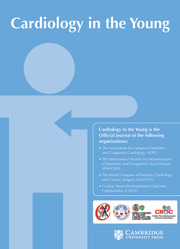No CrossRef data available.
Article contents
Utility of external event recorders in detecting symptom-arrhythmia correlation in children complaining palpitations after successful supraventricular tachycardia ablation
Published online by Cambridge University Press: 31 July 2025
Abstract
The persistence of palpitations in some patients after supraventricular tachycardia ablation is a common challenge despite high procedural success rates. Establishing a correlation between symptoms and tachycardia is especially crucial for adolescent patients, who face challenges in perceiving and articulating their symptoms. This study aimed to evaluate the significance and efficacy of external event recorders in detecting symptom-arrhythmia correlation in paediatric patients experiencing palpitations following successful supraventricular tachycardia ablation.
Among the 1682 patients who underwent successful supraventricular tachycardia ablation at our center between 2013 and 2023, the study included those who met the following criteria: 1) diagnosed with atrioventricular nodal reentrant tachycardia, concealed accessory pathway, or focal atrial tachycardia (excluding substrates identifiable on surface electrocardiogram such as Wolff-Parkinson-White and Mahaim type preexcitations), 2) without CHD, 3) aged over 10 years (as this age is considered sufficient for reliable symptom reporting), and 4) presenting with palpitations post-ablation, with no supraventricular tachycardia detected on electrocardiogram or 24-hour Holter monitoring. Patient data were retrospectively reviewed from medical records.
Among a total of 104 patients reporting palpitations (15%), event recording data of 73 patients were available. Supraventricular tachycardia was documented in eight cases, whereas sinus tachycardia was detected in nine patients. Symptom-arrhythmia correlation was achieved in 23% of patients, nearly half of whom had supraventricular tachycardia recurrence. Patients reporting palpitations with recurrent supraventricular tachycardia episodes were analysed according to diagnostic subgroups. The recurrence rate in patients with palpitations was higher in the focal atrial tachycardia group compared to the others (33%).
Despite successful ablation procedures, palpitations continue to pose a significant concern. To precisely explore the actual symptom-rhythm correlation, we advocate safe and effective utilisation of external event recorders in paediatric patients, particularly those with sporadic symptoms, as opposed to relying solely on electrocardiogram and Holter monitoring.
Information
- Type
- Original Article
- Information
- Copyright
- © The Author(s), 2025. Published by Cambridge University Press


